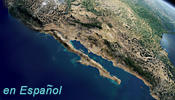![[Ocean Oasis Field Guide]](images/bnr-oo-field.gif)

![[Ocean Oasis Field Guide]](images/bnr-oo-field.gif) |  |
|
Yucca valida AGAVACEAE (Agave Family) | |
|
The generic name refers to a native Caribbean dialect first describing this genus. The specific epithet refers to the Latin validus meaning strong or robust. DescriptionThis yucca grows to 3-7 m (9-21 feet) tall. It is a multi-trunked yucca that may or may not branch. The bark is grayish brown and deeply fissured. The yellowish-green leaves are rigid and lance-like with fibrous and toothless edges, 15-35 cm (6-14 inches) long and 1.5-2.5 cm (1/2-1-inch) wide. Older leaves die and persist as a brown skirt below the green leaves for up to 2 m (6 feet). The flowers are borne on an erect cluster at the tops of the branches. The flowers are creamy white, and are said to have the odor of dill and bloom March-August. The oblong fruit resembles a small bell pepper 2.5-4.5 cm long, and is black when ripe. Range and HabitatThis yucca is a common plant on the Pacific side of the peninsula, and in the west Cape Region at lower elevations, north to Laguna Chapala Seca, at Bahía San Francisco and almost to Arroyo El Rosario. Natural HistoryA tea from the flower buds has been used to treat diabetes and rheumatism. The buds can be eaten like bananas. The flowers are cooked and ground for candy, called colache. The rootstock is used by ranches in the Vizcaíno Desert, as a living fence around the home garden or corral. The name Datilillo translates as "little date" because from a distance groupings of Datilillos resemble groves of date palms. This yucca also superficially resembles the Joshua Tree (Yucca brevifolia). The black ripened fruits of Datilillo are harvested and eaten after boiling or roasting. |

|
Text by Bob Lauri
Photograph by Reid Moran
Field Guide |
Site Index |
Ocean Oasis Introduction
|
|
© 2000 San Diego Natural History Museum |